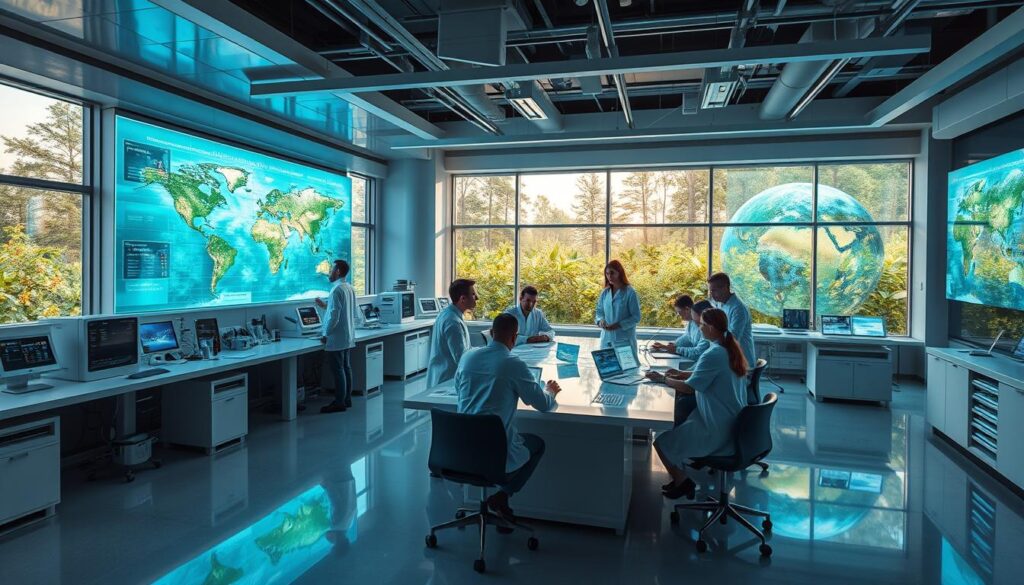It is a fascinating phenomenon that, despite the overwhelming consensus among climate scientists—amounting to 97%—a significant subset of experts persists in questioning the human influence on global warming1. These dissenting voices scrutinize the data on global temperature trends, greenhouse gas emissions, and natural climate variability with an intense skepticism. They present a counter-narrative to the prevailing scientific consensus, challenging the interpretation of climate models, the veracity of historical temperature records, and the intricate dynamics of the Earth’s climate system23.
Their skepticism is not a denial of the planet’s warming; rather, it advocates for a more nuanced examination of all potential contributors to climate change. This approach seeks to refine our comprehension and develop more effective response strategies. In the context of the climate science debate, the significance of human activities, particularly the impacts of fossil fuel combustion and land use changes, cannot be overstated.
Key Takeaways
- A minority of scientists critically analyze the consensus on man-made global warming.
- Challenges to the dominant view focus on data interpretation and reliability.
- Climate models and historical records are areas of intense scrutiny.
- Despite these debates, the objective is to enhance understanding, not deny warming.
- Human activities like fossil fuel combustion are central to these discussions.
Introduction to Man-Made Global Warming
Anthropogenic climate change, commonly referred to as man-made global warming, signifies a substantial rise in Earth’s average surface temperature, primarily caused by human activities. The emission of greenhouse gases, particularly CO2 from the combustion of fossil fuels, has escalated significantly over the past few centuries. This escalation commenced with the Industrial Revolution, a period characterized by unprecedented technological advancements and industrial expansion, thereby substantially augmenting atmospheric CO2 concentrations.
What is Man-Made Global Warming?
Anthropogenic climate change emanates from a variety of human activities that discharge greenhouse gases into the atmosphere, thereby trapping heat and inducing a gradual elevation in global temperatures. The Intergovernmental Panel on Climate Change (IPCC) was instituted to assess and disseminate information on the repercussions of these emissions. The primary catalyst of this warming is the increase in CO2 emissions, predominantly driven by industrial processes and the combustion of fossil fuels such as coal, oil, and natural gas.
The Historical Context of Global Warming
The genesis of anthropogenic climate change can be traced back to the Industrial Revolution, a pivotal era characterized by significant transformations in manufacturing methodologies and energy consumption. This period witnessed an unprecedented surge in CO2 emissions, setting the stage for the climate challenges we face today. Through the analysis of ice core samples, historical weather records, and climate reconstructions, scientists have elucidated that the current warming phase is distinct from previous climatic phases in Earth’s history.
Insights derived from historical analysis are crucial for comprehending the gravity of mitigating these emissions. The rapid escalation in industrial activities during the second half of the 18th century directly correlated with the onset of observable global warming trends. Moreover, by the mid-21st century, an estimated 50% of the world’s arable land will be impacted by soil salinization, further exacerbating the effects of global warming and irrational irrigation practices4.
Aligning with global initiatives such as the United Nations Sustainable Development Goal 7, which focuses on ensuring access to affordable and modern energy, the role of the Intergovernmental Panel on Climate Change becomes increasingly pivotal in devising strategies for a sustainable future5.
Copenhagen exemplifies a pioneering city in climate action. Since 2005, the city has achieved a 75% reduction in CO2 emissions while concurrently experiencing a 25% increase in population6. This achievement underscores the city’s ambitious goals relative to other urban centers globally, highlighting the global imperative for targeted climate actions and sustainable practices.
Scientific Evidence Supporting Man-Made Global Warming
The scientific consensus on man-made global warming is unequivocal, supported by a plethora of research studies and climate data analysis methodologies. These findings are substantiated by the IPCC, which presents extensive datasets and employs innovative climate modeling techniques.
Major Research Studies
Major research studies, spearheaded by the IPCC and other prominent scientific entities, provide compelling evidence for man-made global warming. These endeavors compile global temperature records over decades, incorporating ice cores, ocean sediments, and tree rings as paleoclimate proxies. This meticulous reconstruction of past climates elucidates the human imprint on the current warming trend.

A pivotal discovery indicates that 97% of scientists affirm human causality in climate change7. Conversely, only 12% of US citizens are cognizant of the scientific consensus on this matter7. This disparity underscores a critical awareness gap, with profound implications for policy and decision-making frameworks.
Climate Modeling and Predictions
Climate modeling and prediction are paramount in forecasting future climate scenarios. These models, which account for diverse greenhouse gas emission scenarios, project potential future conditions. The validation of these models against observed climate trends underscores their reliability.
For instance, the Climate Action Tracker suggests that global adherence to Switzerland’s current emissions trajectory could lead to a 3 degrees Celsius warming8. The summer of 2024 in the Balkans, marking Europe’s hottest season on record, highlights the imperative of emission reduction9.
Furthermore, the planet has warmed by approximately 1.2 degrees Celsius since preindustrial times9. Predictive models underscore the necessity for global cooperation, aligning with the goals outlined in IPCC reports.
Advancements in clean energy represent a crucial step towards mitigating climate change. By 2023, global investment in clean energy surpassed $1.8 trillion, heralding a shift towards sustainable energy solutions7. Such investments underscore the scientific consensus on the criticality of carbon emission reduction.
Future climate scenarios delineate a roadmap for understanding and addressing human impacts on global warming. By integrating climate data analysis with predictive models, scientists furnish actionable insights for policymakers and the public, galvanizing a collective commitment to combat climate change.
For further information on climate-related broadcasts and reports, visit this guide on how to watch NFL games without a cable7.
Key Contributors to Man-Made Global Warming
Human endeavors have profoundly altered the global carbon cycle, resulting in elevated carbon emissions and intensifying global warming. The primary drivers of this transformation are fossil fuel combustion and deforestation’s detrimental effects.
Fossil Fuel Combustion
The combustion of fossil fuels for energy and transportation stands as the paramount source of carbon emissions, liberating copious amounts of carbon dioxide and other greenhouse gases into the atmosphere. Industrial processes, including manufacturing and power generation, significantly augment this issue. The International Energy Agency (IEA) indicates that an estimated 760 million individuals globally lack access to electricity, thereby exacerbating energy disparities and perpetuating poverty5. This scenario highlights the imperative for sustainable energy alternatives to counteract the detrimental effects of man-made global warming.
Deforestation and Land Use Changes
Deforestation and alterations in land use are pivotal contributors to man-made global warming, diminishing forests’ carbon sequestration capabilities and escalating methane emissions from agriculture and livestock. Soil salinity affects approximately 950 million hectares globally, and by the mid-21st century, an estimated 50% of the world’s arable land will be impacted by soil salinization, further exacerbating deforestation’s effects4. This amalgamation of deforestation and land degradation not only disrupts local ecosystems but also propels a rise in global temperatures.
The intricate nexus of industrial activities and land management decisions, including deforestation and fossil fuel combustion, presents a formidable challenge in curtailing global carbon emissions. These practices exacerbate the greenhouse effect, necessitating immediate interventions to rebalance the global carbon cycle. For secure transactions in this evolving digital realm, the reliance on reputable e-commerce platforms and secure payment gateways is paramount secure online shopping.
Impacts of Global Warming on Natural Systems
The repercussions of global warming on natural systems are far-reaching, precipitating ecosystem disruption and exacerbating the loss of biodiversity. Alterations in habitats significantly impact numerous species, compelling them to either adapt to novel environmental conditions or risk extinction. The effects manifest through shifting migration patterns and disrupted reproductive cycles, rendering wildlife increasingly susceptible to the volatile climate.

Effects on Wildlife and Biodiversity
The protracted exposure to temperature fluctuations and anthropogenic alterations has severely impacted wildlife and biodiversity. Habitat loss emerges as a paramount threat, necessitating species to migrate or adapt to unfamiliar environments. For instance, regions witnessing a decline of up to 90% in large animal populations due to military activities exemplify the extensive damage5. Furthermore, the diminishing Arctic ice disrupts polar bears’ hunting practices and diminishes their food sources.
Changes in Weather Patterns
Global warming has precipitated significant alterations in weather patterns, inducing an uptick in extreme weather events. Hurricanes, heatwaves, and floods have become increasingly prevalent, further straining affected ecosystems. The concurrent rise in global temperatures has precipitated sea-level rise, posing a persistent threat to coastal regions and island nations as polar ice melts and seawater expands10. The thermal expansion of water exacerbates this predicament, imperiling coastal communities and essential habitats.
“The relentless surge in extreme weather events underscores the urgent need for comprehensive climate strategies to mitigate ecosystem disruption and safeguard biodiversity,” shared Dr. Jane Goodall, renowned primatologist and environmental activist.
These biological and climatological transformations necessitate substantial intervention to maintain the delicate balance of our planet’s ecosystems.
| Impact | Consequence |
|---|---|
| Loss of Biodiversity | Species face extinction and disrupted life cycles |
| Extreme Weather Events | Increased frequency of hurricanes, heatwaves, floods |
| Sea-Level Rise | Threatens coastal habitats and human settlements |
| Habitat Loss | Forces species migration and adaptation |
Human Health and Societal Impacts
The repercussions of global warming on human health and societal frameworks are profound, manifesting in an escalation of climate-related ailments such as heatstroke and respiratory conditions. The surge in heatstroke and respiratory disorders, propelled by ascending temperatures, is affecting millions globally11.
Public Health Risks
Climate-related diseases are proliferating due to the escalating global temperatures. The modification of agricultural landscapes and the alteration in water availability are imperiling food and water security, thereby escalating public health risks11. The detrimental effects of climate change on nutrition, particularly in underdeveloped regions, persist, exacerbating disease prevalence and exacerbating disparities in productivity and income levels11.

Economic Consequences
The economic ramifications of global warming are extensive, influencing sectors such as agriculture, insurance, and real estate. The escalating incidence of extreme weather events incurs substantial economic losses, propagating through global markets and labor forces12. Shifts in agricultural productivity, notably in impoverished nations, necessitate a strategic pivot to sectors less susceptible to climate variability to sustain economic equilibrium. Additionally, the structural weaknesses and inefficient labor markets in developing areas impede the effective utilization of human capital, thereby exacerbating income disparities between affluent and less developed nations11.
Furthermore, climate change precipitates displacement, leading to an increase in climate refugees. Individuals are forced to migrate due to the degradation of environmental conditions, severely impacting their economic well-being and safety. To address these issues, policies must concentrate on fortifying infrastructure and refining labor market efficiencies, thereby optimizing human capital potential12.
Science Against Man-Made Global Warming: Evidence-Based Solutions
The imperative to address man-made global warming demands a comprehensive suite of mitigation strategies, focusing on greenhouse gas reduction. These strategies are designed to mitigate environmental degradation and foster sustainable development through a multifaceted approach. This approach encompasses a variety of measures, from energy efficiency enhancements to sustainable agricultural practices.
Mitigation Strategies
Effective mitigation strategies entail the enhancement of energy efficiency, a critical factor in reducing greenhouse gas emissions. This involves the development of innovative transportation and urban planning policies, aimed at decreasing emissions and promoting sustainable development. Furthermore, the adoption of sustainable agricultural practices significantly contributes to climate action plans. By implementing better techniques and technologies, agricultural emissions can be substantially reduced, ensuring a positive long-term impact on environmental health.
Adoption of Renewable Energy Solutions
The transition to renewable energy sources is essential for a clean energy transition. Embracing renewable energy options such as solar, wind, hydroelectric, and geothermal power is crucial to displace the current reliance on fossil fuels. This shift not only aids in greenhouse gas reduction but also aligns energy consumption with sustainable development goals. The International Energy Agency (IEA) estimates that 760 million people worldwide lack access to electricity, a figure projected to decrease to 745 million by the end of the year5. Addressing this energy inequality necessitates robust climate action plans that prioritize renewable energy investments and infrastructure enhancements.
In regions with limited financial resources, the challenge of environmental degradation exacerbates energy inequality, leading to disparities in energy access and resources5. Therefore, implementing targeted interventions is essential to effectively mitigate these issues and address the unique circumstances of impacted communities. In contrast, wealthier countries often see skilled workers employed in high-productivity sectors like manufacturing and services, contributing to economic growth and supporting the clean energy transition11.
| Energy Source | Contribution to Energy Supply | Carbon Emissions |
|---|---|---|
| Solar Power | Key player in clean energy transition | Minimal |
| Wind Power | Rapidly growing | Minimal |
| Hydroelectric Power | 2018 contribution: 16.6% of global energy supply | Minimal |
| Geothermal Power | Underutilized potential | Minimal |
| Fossil Fuels | Primary current source | High |
Integrating diverse renewable energy sources and optimizing their contribution to energy supply is vital for achieving greenhouse gas reduction and ensuring a sustainable future. The fact that militaries worldwide account for an estimated 6% of all greenhouse gas emissions underscores the need for widespread adoption of clean energy solutions5. By aligning mitigation strategies with robust climate action plans, a resilient global framework can be established, capable of addressing the multifaceted challenges posed by man-made global warming.
Climate Change Solutions and Technological Innovations
Confronting climate change necessitates the deployment of superior solutions and avant-garde innovations. The realm of renewable energy advancements and emission reduction technologies stands at the vanguard of mitigative endeavors. Notably, the evolution of solar and wind technologies has propelled clean energy solutions to prominence, offering efficiency and affordability. Concurrently, the evolution of energy storage systems and the advent of smart grids has augmented the dependability and efficacy of renewable energy frameworks.
Advancements in Clean Energy Technology
The realm of clean energy technology is pivotal in diminishing carbon emissions and combating climate change. Innovations within solar panels and wind turbines have elevated these technologies to new efficiencies and affordability. The advent of smart grids and advanced energy storage systems facilitates superior management and distribution of renewable energy. These technologies not only underpin emission reduction but also enhance energy security and stimulate economic growth.
Statistical data reveal that universal access to electricity by 2030 necessitates the connection of nearly 100 million individuals annually 5. Conversely, an estimated 760 million individuals globally lack electricity access, with projections indicating a reduction to 745 million by year’s end5. Within the European Union, the energy-poor population ranges from 50 to 125 million individuals5.

Illustratively, a 200% increase in mangrove coverage on intertidal oyster reefs in Mosquito Lagoon was observed from 1943 to 202113. This phenomenon exemplifies a positive outcome of technological and ecological restoration endeavors. Such projects highlight the synergy between technological innovation and environmental stewardship in addressing climate change13.
Carbon Capture and Storage
Carbon capture and storage (CCS) emerges as a pivotal technological innovation for climate change mitigation. CCS entails the capture of carbon dioxide emissions from industrial processes and power generation at their source, followed by its subterranean storage, thereby preventing atmospheric release. This technology is instrumental in emission reduction, particularly in sectors where carbon abatement is formidable.
The efficacy of CCS technologies is contingent upon technical feasibility, political will, economic incentives, and social acceptance. Effective CCS deployment can significantly diminish CO2 emissions, thereby contributing to global carbon sequestration efforts. Furthermore, initiatives such as the United Nations Sustainable Development Goal 7 aim to ensure universal access to affordable, reliable, and modern energy by 20305. These objectives are crucial for fostering energy justice and alleviating the detrimental impacts of energy inequality on societal and environmental fronts.
Climate innovation projects such as these underscore the potential of technological advancements to catalyze both environmental and social transformations. The sustained support and integration of such technologies are essential for the realization of sustainable energy solutions and climate resilience.
Environmental Activism and Policy Interventions
Environmental activism and policy interventions are essential in combating man-made global warming. At both local and global levels, policies such as emission standards, conservation initiatives, and green building codes are crucial for driving change. These measures are fundamental to the ongoing efforts aimed at mitigating the adverse effects of climate change.

Global and Local Environmental Policies
Local environmental regulations, mandating emission reductions and promoting green infrastructure, are pivotal in combating climate change. On a global scale, climate policies are crafted to address the pressing issues of a warming planet. Such policies often include stringent rules on industrial emissions, aimed at curtailing the overall carbon footprint.
The Role of International Agreements
International agreements, such as the Paris Agreement, are vital in setting global aspirations to limit warming and reduce carbon footprints. The Paris Agreement acts as a cornerstone for global collaboration, compelling signatory countries to set ambitious targets for greenhouse gas emissions reduction. By fostering cooperation and commitment across borders, these agreements promote a unified approach to climate policies and sustainable legislation.
The effectiveness of such agreements, however, is contingent upon the political and economic landscapes of the member countries. This complexity makes their implementation and enforcement a formidable task. For instance, Helion Energy’s goal to achieve electricity production at about $0.01 per kilowatt-hour, with its first commercial-scale fusion power plant targeted for operation by 2028, highlights the significance of investing in innovative technologies to meet international goals14.
Furthermore, the competition for limited green energy projects intensifies the pressure on tech companies to comply with international environmental regulations. Companies such as Amazon, Google, and Microsoft have set targets to operate data centers on 100% renewable energy by 2025 and 2030, respectively, significantly contributing to global climate efforts14.
Combating Global Warming: Success Stories
The challenge of combating global warming is formidable, yet numerous successful climate action narratives from worldwide underscore the efficacy of both national and community-driven initiatives. These case studies elucidate the profound impact of grassroots movements and sustainable community projects on global warming mitigation efforts.
Case Studies from Around the World
In the United States, the presence of 3.9 million orphaned oil and gas wells constitutes a significant environmental hazard, primarily due to methane emissions10. The Youth Climate Initiative, spearheaded by Sebastian Ng, has garnered funds to rectify this issue in Akron, Ohio, and Montana, spotlighting the problem and engendering a positive environmental transformation10. To date, they have amassed $11,000 for an Akron well and surpassed $3,300 towards a $20,000 goal in Montana10. This exemplifies the efficacy of community engagement in tackling climate-related challenges.
Worldwide, the investment in clean energy has skyrocketed, with an estimated $1.8 trillion annually channeled into these endeavors by 20237. This influx of funding has catalyzed advancements in renewable energy and other mitigation strategies. Moreover, countries such as China continue to bolster clean energy investments, despite the challenges posed by escalating carbon dioxide emissions, which rose by 5.2% in 20237. However, a heightened investment is imperative to significantly mitigate global warming.

Community-Level Initiatives
Community-level initiatives stand as a testament to climate action success. Grassroots movements often lead local projects aimed at specific environmental issues, such as the remediation of orphaned wells. The Well Done Foundation, since its inception in 2019, has plugged 44 high-priority orphan wells10. Their endeavors illustrate how grassroots initiatives can substantively contribute to global warming mitigation by promoting environmental stewardship.
Despite the political divide in the United States regarding climate change, with only 38% of Republicans acknowledging human activity’s substantial contribution7, community-led initiatives like those by the Youth Climate Initiative instill optimism and facilitate broader acceptance and action. Such projects are crucial in bridging the chasm between political ideologies and environmental duties.
These narratives of success highlight that effective climate action necessitates a synergy of national policies, substantial investments, and vigorous community engagement. The synergy between global policies and grassroots movements can indeed catalyze sustainable change and alleviate the detrimental effects of global warming.
Delve deeper into how Cary students are tackling the environmental menace of orphaned oil wells through their impactful grassroots movements and projects here.
Sustainable Practices for Reducing Carbon Footprint
Adopting a low-carbon lifestyle is paramount for individuals intent on diminishing their carbon footprint and fostering environmental stewardship. Engaging in straightforward actions can significantly impact the reduction of individual carbon emissions. Initiatives such as the adoption of energy-efficient appliances, recycling, and the preference for public transportation or eco-friendly vehicles stand out as effective strategies. The fact that an estimated 745 million people globally are predicted to lack access to electricity by year’s end underscores the criticality of energy-efficient practices in harmonizing global energy demands with carbon emission reduction5.
Everyday Actions for Individuals
Individuals can significantly contribute to environmental stewardship by adopting a low-carbon lifestyle through several measures:
- Utilizing energy-efficient lighting and appliances.
- Committing to recycling and reducing waste.
- Choosing sustainable transportation methods like biking, carpooling, or using public transport.

Advocating for green consumerism by selecting products from companies with sustainable practices can exponentially enhance individual contributions. For instance, an increase in daily walking and biking from 4 to 22 minutes can lead to a 14% reduction in cardiovascular disease and diabetes, thereby bolstering health while championing sustainability15.
Corporate Responsibility and Sustainability
At a macro level, corporate sustainability plans are instrumental in combating global warming. Companies are increasingly being held to account for their environmental footprint, prompting them to implement comprehensive sustainability strategies. These strategies might encompass green supply chains, corporate carbon offset initiatives, and circular economy principles to diminish waste and resource utilization. In the EU, a considerable number of individuals face energy poverty, with estimates ranging from 50 to 125 million due to elevated energy costs and diminished incomes5. Addressing these disparities through sustainable corporate endeavors can yield a significant positive societal impact.
| Corporate Initiatives | Impact |
|---|---|
| Green Supply Chains | Reduction in carbon emissions and waste |
| Carbon Offset Programs | Neutralizing corporate carbon footprints |
| Circular Economy | Minimized resource use and waste generation |
Furthermore, environmental stewardship by corporations transcends internal practices. Many leading enterprises are now concentrating on extensive community engagement, encapsulating corporate responsibility within sustainable outreach programs and backing green infrastructure developments like bike paths and sustainable urban planning. This approach not only fosters green consumerism13 and15 but also underscores the importance of corporate responsibility in societal development.
Climate Action Initiatives by Governments
Government-led climate initiatives are paramount in tackling the complex issue of global warming. These initiatives encompass a spectrum of activities, including enhancing energy efficiency, reforestation, and constructing sustainable transportation infrastructure. Such endeavors not only diminish greenhouse gas emissions but also cultivate healthier, more resilient communities. The armed forces, for instance, account for approximately 6% of global greenhouse gas emissions, underscoring the significance of targeted reductions in this sector5. Furthermore, projections indicate a potential reduction to 745 million individuals without access to electricity, highlighting the potential for policy innovation to catalyze significant change5.
Interdisciplinary research collaborations are instrumental in shaping these policies. By amalgamating expertise from scientists, policymakers, and industry leaders, these collaborations facilitate the creation of evidence-based, technologically advanced climate resilience strategies. These partnerships enhance knowledge exchange, thereby fostering innovative solutions and resilience measures to counteract climate change’s impacts. For example, such collaborations have revealed that the EU faces between 50 and 125 million energy-poor citizens, underscoring the urgency for targeted interventions5.
National Programs and Policies
National programs aimed at energy efficiency have demonstrated substantial potential in curtailing carbon emissions and promoting sustainability. Countries that have implemented comprehensive energy efficiency measures have achieved notable energy savings and a reduced carbon footprint. The EU’s challenge of between 50 and 125 million energy-poor citizens underscores the necessity for robust energy policies5. Moreover, policy innovations in reforestation have significantly contributed to carbon sequestration and biodiversity conservation. Nations such as Norway and New Zealand have set ambitious reforestation targets, reflecting their dedication to climate resilience strategies.
Collaboration with Scientists and Researchers
Collaboration between governments, scientists, and researchers is crucial in formulating effective climate policies. These interdisciplinary research collaborations ensure that scientific insights are seamlessly integrated into policy formulation, resulting in strategies that are both practical and effective. African Ministers are advocating for a New Collective Quantified Goal (NCQG) on climate finance, estimated at $1.3 trillion per year, to support developing nations16. Such collaborations are vital for mobilizing the required finance through grants and concessional finance, thereby averting further debt burdens on vulnerable countries16. By aligning academic research with policy objectives, the knowledge-action gap is bridged, leading to more resilient and adaptive communities.
For instance, the concerted efforts of local communities, universities, government agencies, and NGOs are essential for the preservation of traditional systems like Bali’s subak, a UNESCO World Heritage site17. The adaptability of Balinese farmers to climate change challenges exemplifies the efficacy of collaborative research and policy-driven support17.

Further insights on the repercussions of energy inequality and the imperative for universal access to affordable, reliable, and modern energy sources can be discovered here5.
The Future of Global Warming Research
The trajectory of global warming research is set to navigate through pivotal challenges with the advent of novel trends in climate science. At the vanguard, climate research advancements are being propelled by the integration of advanced climate modeling and satellite-based monitoring systems. These innovations are not only enhancing predictive accuracy but also deepening our comprehension of environmental transformations. The imperative for substantial funding and unwavering support for sustainability cannot be overstated, as these elements are fundamental to propelling these breakthroughs forward.
Emerging Trends in Climate Science
Climate science is witnessing a paradigm shift with the emergence of refined modeling methodologies capable of delineating the intricate interplay between human activities and global climate dynamics. The deployment of satellite-based systems has significantly augmented our observational capabilities, enabling the continuous monitoring of the earth’s carbon sinks. This technological leap has been underscored by a burgeoning consensus among experts, as evidenced by the escalating ratio of endorsements for these technologies18. Concurrently, the surge in expert advocacy for intensified global warming research over the decade underscores the field’s burgeoning confidence and ambition18.
Funding and Supporting Green Innovation
The sustenance of progress in climate adaptation and mitigation necessitates robust funding and a commitment to green tech investment. An examination of funding patterns across diverse regions reveals a stark disparity, with certain regions exhibiting a pronounced preference for man-made global warming research18. The confluence of political and financial support is instrumental in the genesis and implementation of climate adaptation technologies. A global trend towards renewable energy investment is evident, with a marked shift away from fossil fuel projects18.
Engagement from both the public and private sectors is indispensable in expediting the adoption of climate change technologies and propelling the sustainability agenda. International policy dialogues are increasingly dedicated to global warming, fostering a collaborative approach18. Moreover, the strategic deployment of human resources is critical in surmounting infrastructural hurdles and optimizing skill sets, essential for sustainable development. Harnessing human potential is paramount in addressing the dual challenges of climate change and urbanization further insights19.

| Region | Funding for Global Warming Research | Investment in Renewable Energy | Focus on Climate Adaptation |
|---|---|---|---|
| North America | High | Moderate | Strong |
| Europe | Moderate | High | Strong |
| Asia | Low | Moderate | Moderate |
| Latin America | Low | Low | Emerging |
Conclusion
The climate change debate necessitates a rigorous, unbiased analysis of the scientific evidence, demanding critical thinking. The phenomenon of man-made global warming constitutes a profound threat to our planet’s future, with its intricacies manifesting through its projected effects on agriculture and natural ecosystems. For example, the anticipated impact of global warming and inadequate irrigation practices on soil salinization is alarming, with approximately 50% of the world’s arable land projected to be affected by 20504. This statistic underscores the imperative of global cooperation and concerted environmental stewardship to avert this looming crisis.
The scientific fraternity is instrumental in formulating evidence-based solutions to this crisis. Research elucidates the indispensable role of potassium (K+) in plant development and salt stress mitigation, with specific transporters and channel families, such as Shaker, playing pivotal roles in crops like rice4. Innovations in irrigation, exemplified by soybean cultivation in southern Xinjiang, where irrigation reduction by 50% has led to enhanced crop yield stability and sustainability, underscore the efficacy of such scientific advancements20. Such findings underscore the significance of global responsibility in mitigating global warming.
Effective climate action is contingent upon a harmonious blend of skepticism, which ensures scientific rigor, and optimism, which propels practical, scalable solutions. By spotlighting global success stories and community-driven initiatives, we are motivated to embrace sustainable practices and collaborate towards a future that is both sustainable and resilient. Engaging constructively in the climate change discourse is paramount, and a balanced, informed stance is our most viable strategy for tackling the complex challenges posed by global warming. For an in-depth exploration of potassium’s role in plant growth and salt stress response, refer to the comprehensive study here4.
FAQ
What is Man-Made Global Warming?
What is the historical context of global warming?
What evidence supports man-made global warming?
What are the main contributors to man-made global warming?
How does global warming impact natural systems?
What are the human health and societal impacts of global warming?
What mitigation strategies are there for man-made global warming?
What technological innovations help combat global warming?
How do environmental activism and policy interventions contribute?
Can you provide examples of success stories in combating global warming?
How can individuals reduce their carbon footprint?
What actions are corporations taking to address global warming?
How do governments contribute to climate action initiatives?
What are the emerging trends in global warming research?
Source Links
- https://www.rand.org/pubs/commentary/2024/09/ukraine-kursk-and-the-importance-of-lines-of-operation.html – Ukraine, Kursk, and the Importance of Lines of Operation in History
- https://www.nytimes.com/2024/09/06/arts/music/amplifier-newsletter-mj-lenderman.html – Meet MJ Lenderman, Southern Rock’s Tragicomic Poet
- https://www.nasa.gov/podcasts/houston-we-have-a-podcast/gateway-at-your-service/ – Gateway: At Your Service – NASA
- https://www.mdpi.com/1422-0067/25/17/9728 – Identification and Characterization of Shaker Potassium Channel Gene Family and Response to Salt and Chilling Stress in Rice
- https://www.mdpi.com/1996-1073/17/17/4500 – Towards Energy Equity: Understanding and Addressing Multifaceted Energy Inequality
- https://www.lemonde.fr/en/international/article/2024/09/07/copenhagen-s-dream-of-becoming-a-low-carbon-city_6725196_4.html – Copenhagen’s dream of becoming a low-carbon city
- https://flaglerlive.com/climate-change-consensus/ – Why Still a Gap Between Public Opinion and Scientific Consensus on Climate Change? | FlaglerLive
- https://www.euronews.com/green/2024/09/07/an-embarrassment-experts-explain-what-could-happen-as-switzerland-rejects-landmark-climate – Elderly Swiss women won a climate case but it’s not been plain sailing
- https://www.yahoo.com/news/balkans-region-grappled-hottest-summer-073311434.html – How the Balkans region grappled with the hottest summer in more than a century
- https://www.wral.com/story/from-classroom-to-climate-action-cary-teen-works-to-cap-abandoned-oil-wells/21611986/ – From classroom to climate action: Cary teen works to cap abandoned oil wells
- https://www.devdiscourse.com/article/other/3077163-from-barriers-to-growth-utilizing-human-capital-for-a-prosperous-future – From Barriers to Growth: Utilizing Human Capital for a Prosperous Future | Other
- https://cepr.org/voxeu/columns/religion-matters-economic-growth-through-various-channels – Religion matters for economic growth through various channels
- https://www.mdpi.com/2076-3298/11/9/193 – Ecological Shifts: Plant Establishment in an Animal-Based Ecosystem
- https://www.intelligentliving.co/helion-nuclear-fusion-ai-energy/ – Helion Energy’s Nuclear Fusion: Game-Changer for AI’s Energy Hunger and Sustainable Future
- https://www.mdpi.com/2412-3811/9/9/153 – Assessing Heterogeneity Among Cyclists Towards Importance of Bicycle Infrastructural Elements in Urban Areas
- https://www.environewsnigeria.com/amcen-african-leaders-make-a-1-3tr-case-to-avert-climate-dangers/ – AMCEN: African leaders make a $1.3tr case to avert climate dangers – EnviroNews – latest environment news, climate change, renewable energy
- https://www.straitstimes.com/asia/se-asia/climate-change-could-wipe-out-bali-s-iconic-paddy-fields-and-other-top-unesco-sites-study – Climate change could wipe out Bali’s iconic padi fields and other top Unesco sites: Study
- https://finance.yahoo.com/news/sap-se-sap-among-best-051936055.html – SAP SE (SAP): Among the Best Cloud Stocks to Buy According to Short Sellers
- https://www.euractiv.com/section/global-europe/news/venezuela-opposition-candidate-gonzalez-leaves-for-spain-as-diplomatic-tensions-rise/ – Venezuela opposition candidate González leaves for Spain as diplomatic tensions rise
- https://www.mdpi.com/2223-7747/13/17/2525 – Soybean Yield Simulation and Sustainability Assessment Based on the DSSAT-CROPGRO-Soybean Model


